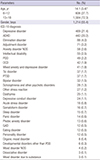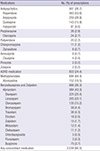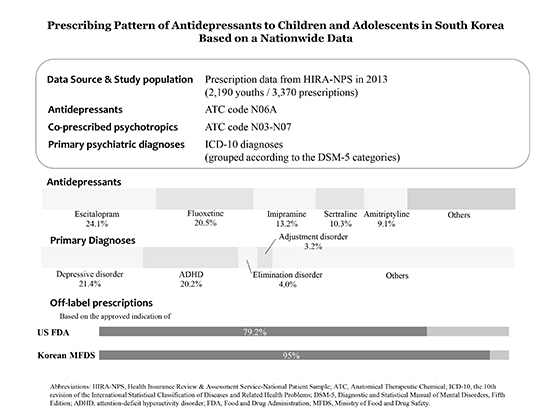1. Meng X, D'Arcy C, Tempier R. Long-term trend in pediatric antidepressant use, 1983–2007: a population-based study. Can J Psychiatry. 2014; 59:89–97.
2. Schröder C, Dörks M, Kollhorst B, Blenk T, Dittmann RW, Garbe E, Riedel O. Outpatient antidepressant drug use in children and adolescents in Germany between 2004 and 2011. Pharmacoepidemiol Drug Saf. 2017; 26:170–179.
3. Mojtabai R, Olfson M, Han B. National trends in the prevalence and treatment of depression in adolescents and young adults. Pediatrics. 2016; 138:e20161878.
4. Gu Q, Dillon CF, Burt VL. Prescription drug use continues to increase: U.S. prescription drug data for 2007–2008. NCHS Data Brief. 2010; 1–8.
5. Bennett K, Teeling M, Feely J. Overprescribing antidepressants to children: pharmacoepidemiological study in primary care. BMJ. 2005; 331:1451–1452.
6. Volkers AC, Heerdink ER, van Dijk L. Antidepressant use and off-label prescribing in children and adolescents in Dutch general practice (2001–2005). Pharmacoepidemiol Drug Saf. 2007; 16:1054–1062.
7. Vitiello B, Zuvekas SH, Norquist GS. National estimates of antidepressant medication use among U.S. children, 1997–2002. J Am Acad Child Adolesc Psychiatry. 2006; 45:271–279.
8. Lee E, Teschemaker AR, Johann-Liang R, Bazemore G, Yoon M, Shim KS, Daniel M, Pittman J, Wutoh AK. Off-label prescribing patterns of antidepressants in children and adolescents. Pharmacoepidemiol Drug Saf. 2012; 21:137–144.
9. Chee KY, Tripathi A, Avasthi A, Chong MY, Xiang YT, Sim K, Kanba S, He YL, Lee MS, Chiu HF, et al. Prescribing pattern of antidepressants in children and adolescents: findings from the research on Asia psychotropic prescription pattern. East Asian Arch Psychiatry. 2016; 26:10–17.
10. Kim JA, Yoon S, Kim LY, Kim DS. Towards actualizing the value potential of Korea Health Insurance Review and Assessment (HIRA) data as a resource for health research: strengths, limitations, applications, and strategies for optimal use of HIRA data. J Korean Med Sci. 2017; 32:718–728.
11. Kim L, Kim JA, Kim S. A guide for the utilization of health insurance review and assessment service national patient samples. Epidemiol Health. 2014; 36:e2014008.
12. Park SC, Lee MS, Kang SG, Lee SH. Patterns of antipsychotic prescription to patients with schizophrenia in Korea: results from the health insurance review & assessment service-national patient sample. J Korean Med Sci. 2014; 29:719–728.
13. Lee H, Oh SH, Cho H, Cho HJ, Kang HY. Prevalence and socio-economic burden of heart failure in an aging society of South Korea. BMC Cardiovasc Disord. 2016; 16:215.
14. Park S, Cho MJ, Bae JN, Chang SM, Jeon HJ, Hahm BJ, Son JW, Kim SG, Bae A, Hong JP. Comparison of treated and untreated major depressive disorder in a nationwide sample of Korean adults. Community Ment Health J. 2012; 48:363–371.
15. Costello EJ, Egger H, Angold A. 10-year research update review: the epidemiology of child and adolescent psychiatric disorders: I. Methods and public health burden. J Am Acad Child Adolesc Psychiatry. 2005; 44:972–986.
16. Cho SC, Go BJ, Kim BS, Kim BN, Kim JW, Shin MS, Yoo HI, Lee DW, Lee JY, Lee JW, et al. The 2005 Seoul Child and Adolescent Mental Health Survey. Seoul: Seoul Child and Adolescent Mental Health Center;2006.
17. Korea Centers for Disease Control and Prevention. Statistics of the 12th Korea Youth Risk Behavior Web-based Survey (KYRBWS) in 2016. Sejong: Korea Centers for Disease Control and Prevention;2016.
18. Lin HC, Tang TC, Yen JY, Ko CH, Huang CF, Liu SC, Yen CF. Depression and its association with self-esteem, family, peer and school factors in a population of 9586 adolescents in southern Taiwan. Psychiatry Clin Neurosci. 2008; 62:412–420.
19. Park HY, Heo J, Subramanian SV, Kawachi I, Oh J. Socioeconomic inequalities in adolescent depression in South Korea: a multilevel analysis. PLoS One. 2012; 7:e47025.
20. Kang EH, Hyun MK, Choi SM, Kim JM, Kim GM, Woo JM. Twelve-month prevalence and predictors of self-reported suicidal ideation and suicide attempt among Korean adolescents in a web-based nationwide survey. Aust N Z J Psychiatry. 2015; 49:47–53.
21. Lee MS, Hoe M, Hwang TY, Lee YM. Service priority and standard performance of community mental health centers in South Korea: a delphi approach. Psychiatry Investig. 2009; 6:59–65.
22. Bhatia SK, Bhatia SC. Childhood and adolescent depression. Am Fam Physician. 2007; 75:73–80.
23. Eguale T, Buckeridge DL, Verma A, Winslade NE, Benedetti A, Hanley JA, Tamblyn R. Association of off-label drug use and adverse drug events in an adult population. JAMA Intern Med. 2016; 176:55–63.
24. Park KJ, Shon S, Lee HJ, Joo Y, Youngstrom EA, Kim HW. Antidepressant-emergent mood switch in Korean adolescents with mood disorder. Clin Neuropharmacol. 2014; 37:177–185.
25. Guille C, Shriver A, Demopulos C, Sachs G. Bupropion vs. desipramine in the treatment of bipolar depression. Bipolar Disord. 1999; 1:33.
26. Post RM, Altshuler LL, Leverich GS, Frye MA, Nolen WA, Kupka RW, Suppes T, McElroy S, Keck PE, Denicoff KD, et al. Mood switch in bipolar depression: comparison of adjunctive venlafaxine, bupropion and sertraline. Br J Psychiatry. 2006; 189:124–131.
27. Vieta E, Martinez-Arán A, Goikolea JM, Torrent C, Colom F, Benabarre A, Reinares M. A randomized trial comparing paroxetine and venlafaxine in the treatment of bipolar depressed patients taking mood stabilizers. J Clin Psychiatry. 2002; 63:508–512.
28. Viktorin A, Lichtenstein P, Thase ME, Larsson H, Lundholm C, Magnusson PK, Landén M. The risk of switch to mania in patients with bipolar disorder during treatment with an antidepressant alone and in combination with a mood stabilizer. Am J Psychiatry. 2014; 171:1067–1073.
29. Merikangas KR, He JP, Burstein M, Swanson SA, Avenevoli S, Cui L, Benjet C, Georgiades K, Swendsen J. Lifetime prevalence of mental disorders in U.S. adolescents: results from the National Comorbidity Survey Replication--Adolescent Supplement (NCS-A). J Am Acad Child Adolesc Psychiatry. 2010; 49:980–989.
30. Varigonda AL, Jakubovski E, Bloch MH. Systematic review and meta-analysis: early treatment responses of selective serotonin reuptake inhibitors and clomipramine in pediatric obsessive-compulsive disorder. J Am Acad Child Adolesc Psychiatry. 2016; 55:851–859.e2.
31. Dobson ET, Strawn JR. Pharmacotherapy for pediatric generalized anxiety disorder: a systematic evaluation of efficacy, safety and tolerability. Paediatr Drugs. 2016; 18:45–53.
32. Keeshin BR, Strawn JR. Psychological and pharmacologic treatment of youth with posttraumatic stress disorder: an evidence-based review. Child Adolesc Psychiatr Clin N Am. 2014; 23:399–411. x
33. Jafarinia M, Mohammadi MR, Modabbernia A, Ashrafi M, Khajavi D, Tabrizi M, Yadegari N, Akhondzadeh S. Bupropion versus methylphenidate in the treatment of children with attention-deficit/hyperactivity disorder: randomized double-blind study. Hum Psychopharmacol. 2012; 27:411–418.
34. Spencer T, Biederman J, Coffey B, Geller D, Crawford M, Bearman SK, Tarazi R, Faraone SV. A double-blind comparison of desipramine and placebo in children and adolescents with chronic tic disorder and comorbid attention-deficit/hyperactivity disorder. Arch Gen Psychiatry. 2002; 59:649–656.
35. Pliszka SR. Psychiatric comorbidities in children with attention deficit hyperactivity disorder: implications for management. Paediatr Drugs. 2003; 5:741–750.
36. Shamseddeen W, Clarke G, Keller MB, Wagner KD, Birmaher B, Emslie GJ, Ryan N, Asarnow JR, Porta G, Brent DA. Adjunctive sleep medications and depression outcome in the treatment of serotonin-selective reuptake inhibitor resistant depression in adolescents study. J Child Adolesc Psychopharmacol. 2012; 22:29–36.
37. Decoutere L, De Winter S, Vander Weyden L, Spriet I, Schrooten M, Tournoy J, Fagard K. A venlafaxine and mirtazapine-induced serotonin syndrome confirmed by de- and re-challenge. Int J Clin Pharm. 2012; 34:686–688.
38. Comer JS, Olfson M, Mojtabai R. National trends in child and adolescent psychotropic polypharmacy in office-based practice, 1996–2007. J Am Acad Child Adolesc Psychiatry. 2010; 49:1001–1010.
39. Safer DJ, Rajakannan T, Burcu M, Zito JM. Trends in subthreshold psychiatric diagnoses for youth in community treatment. JAMA Psychiatry. 2015; 72:75–83.
40. Weersing VR, Jeffreys M, Do MT, Schwartz KT, Bolano C. Evidence base update of psychosocial treatments for child and adolescent depression. J Clin Child Adolesc Psychol. 2017; 46:11–43.










 PDF
PDF ePub
ePub Citation
Citation Print
Print




 XML Download
XML Download